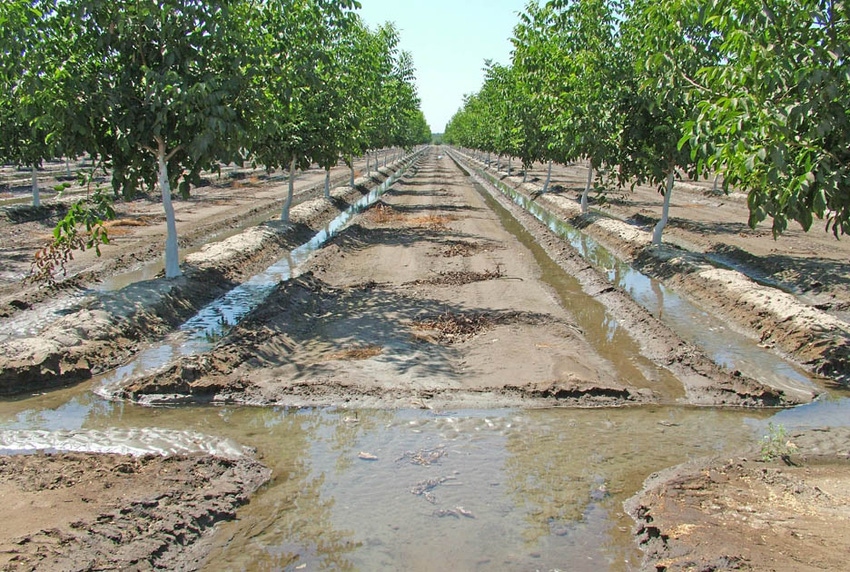
Protecting groundwater quality from nitrate contamination when fertilizing walnut trees requires being on top of your game in managing not only your nitrogen applications but also your irrigation system.
The goal is to allocate your total N budget through the season so that you feed the trees only the amount of N they need and only when they need it, explains Allan Fulton, University of California Cooperative Extension irrigation and water resources advisor for Tehama County.
Previous research suggests that about 20 pounds of N per 1,000 pounds of dry in-shell walnuts may be exported from an orchard at harvest, he notes. Because these studies of N use by walnut were conducted more than two decades ago, researchers are now doubling checking this rule of thumb for modern walnut varieties.
More from Western Farm Press
Chipotle ads disgraceful to farmers everywhere
What happens if US loses California food production?
Drought is farmers’ ‘ah-hah’ moment on environmentalism
Apply too much N or put it on at the wrong time and unused portions of the nutrient can leach out of the root zone in the form of nitrate, threatening groundwater quality.
The depth of the root zone depends on the age of the walnut tree and soil characteristics. In uniform, loose soils, mature walnut trees may sink their roots as deep 8 to 10 feet into the ground. In layered, compacted soils, these roots may be able to push no deeper than about 3 to 5 feet, Fulton reports.
“The younger, finer roots that take up nutrients most efficiently are usually found in top 3 feet or so of the soil profile,” he says. “The deeper roots are not as dense and are more involved with taking up water and anchoring the tree than taking up nutrients.”
Even if your timing and rate of nitrogen application is optimum, an inefficient irrigation system can still put ground water quality and your profits at risk. Consider the case where faulty emitters are applying more water in some areas of your orchard than your trees need, causing the excess N to leach out.
“Then, you’ve set yourself up for a double whammy,” Fulton says. “If you’ve limited nitrogen applications to no more than the crop needs, but you lose some to leaching, you can add nitrates to groundwater. Plus, the trees won’t get all the nitrogen they need for proper growth and nut production.”
Timing of your N applications should coincide with the trees’ nutrient needs, he notes. University of California research shows that prior to bud break, walnut trees draw N from reserves stored in the tree from the previous season and not from fertilizer applied to the soil in the current season. So, rather than risk the loss of any N applied during dormancy or near bud break, Fulton recommends waiting to make the first N application until after bloom is complete.
Added assurance
“If you put on nitrogen before that and then it rains, there’s a good chance of nitrogen leaching out of the root zone,” he says.
Fulton recommends making the initial N application within the first 30 days or so of bloom. That way it’s available from early May through June, when N uptake by walnut trees is the most intensive of the season.
More frequent applications of N at lower rates throughout the season result in more efficient use of N than one or two large applications, he reports. He suggests following the post-flowering treatment with at least three more applications treatments on about a 30-day interval.
When applying N through the irrigation system, uniform application of water and nutrients is critical for making the most efficient use of N, Fulton adds “It’s better to put on N in the last half or even last quarter of the irrigation set,” he says. “You want to run enough water through the system to distribute all of the N but not so much that you begin leaching it out of the root zone.”
For added assurance in monitoring how well your N application rates are in line with tree uptake, Fulton advises confirming that your N fertilizer strategy is on track with an annual summer leaf tissue test. In other nut crops, such as almonds, spring leaf tissue sampling methods have been developed to give growers earlier insight into their N management strategies. “Research is underway to develop an earlier leaf tissue sampling method for walnuts,” he says. “It should be available as a management tool to growers in a few years.”
Fulton also suggests soil tests to measure N levels in the soil. He recommends sampling at incremental depths to evaluate the N distribution in the root zone. Collecting composite soil samples will give you more representative results and repeated sampling every few years at the same time each season will be easier to interpret and more informative. “If your N budget results in adequate N tissue levels and your soil tests show N is not excessive, then you can be confident your N management is on track” he says.
More from Western Farm Press
Chipotle ads disgraceful to farmers everywhere
About the Author(s)
You May Also Like




